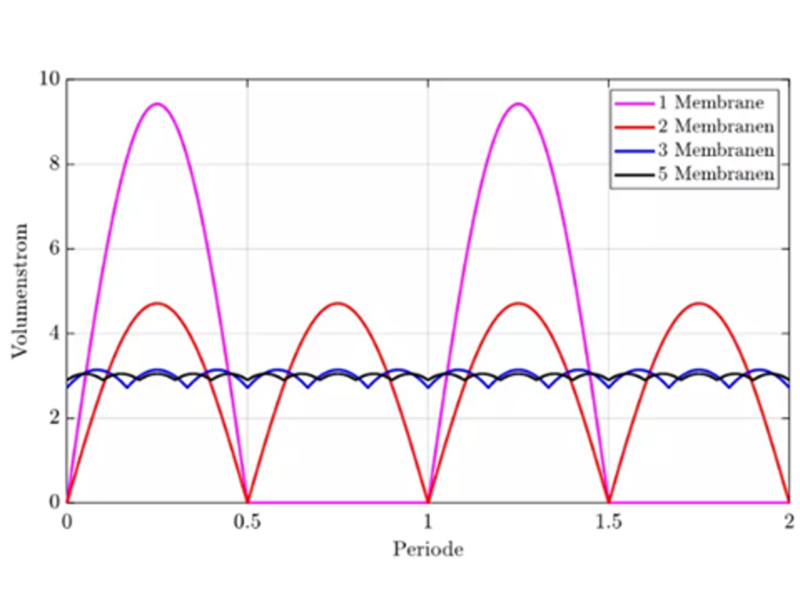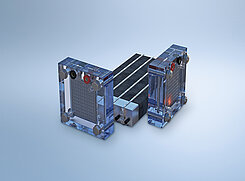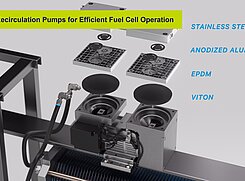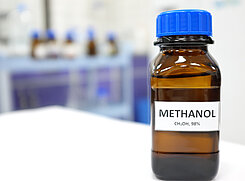Benefits of Methanol as a Hydrogen Carrier
CH3OH – the chemical formula already suggests it: Methanol bonds to hydrogen in liquid form. This property gives methanol unbeatable advantages as an energy source for fuel cells:
Methanol is easier to transport than hydrogen
Methanol is easier to store than hydrogen
Methanol has ten times the energy density of hydrogen
Methanol is a standardized commodity and available worldwide

How Do Methanol Fuel Cells With Reformer Work?
There are two possible functional principles: the direct fuel cell and the indirect fuel cell. Direct-methanol fuel cells (DMFC) convert a methanol-water mixture into hydrogen and carbon dioxide.
Indirect (or reformed) methanol fuel cells use a reformer to convert the mixture into hydrogen. A KNF liquid pump delivers the methanol to the reformer, where, at high temperatures, a hydrogen-containing gas (reformate gas) forms. The reformate gas is then transferred to the anode, where the chemical energy is converted into electrical energy.
Benefits of Reformed Methanol Fuel Cells
It may seem that a reformer as an additional component to a methanol fuel cell would create disadvantages compared with a direct-methanol fuel cell. However, the conversion process of the indirect methanol fuel cell comes with significant advantages:
Hydrogen gas and not liquid methanol is the fuel for the anode, increasing the efficiency of the methanol fuel cell by up to 50 %. DMFCs only have an efficiency of up to 30 %.
The fuel is gaseous and therefore less sensitive to ambient temperature.
Indirect methanol fuel cells operated as high temperature fuel cells are less sensitive to lower purity of methanol, which means they can run on green methanol generated from biogas, for example.
Benefits of Low-pulsation Pumping to the Methanol Fuel Cell Reformer
Methanol is reformed into hydrogen-rich gas for the fuel cell. The reformer’s performance has a significant impact on the dynamics of the fuel cell system. As in any other chemical reaction, the quality of the steam reforming depends on stable temperature and pressure within the reformer.
The stability is already affected by the feeding of the liquid methanol, or rather the methanol-water mixture. The lower the pulsation when feeding into the reformer, the better. If the methanol and deionized water flow evenly into the reformer, evaporation is uniform. Pressure peaks are prevented, the temperature and pressure remain stable.
The pressure conditions in the methanol fuel cell reformer affect the carbon monoxide content of the reformate gas. Carbon monoxide causes so-called poisoning of the methanol fuel cell, drastically reducing its service life. The CO content tends to increase under growing pressure. Pumping the gas into the reformer with low pulsation prevents pressure peaks, preserving the service life of the methanol fuel cells.
KNF liquid pumps combine the benefits of diaphragm pump technology with those of gear pump technology. They are self-priming and safe to run dry, but most importantly, they operate with a low level of pulsation.
The KNF Smooth Flow series of liquid pumps is designed to provide this unique combination of features.
KNF Smooth Flow Liquid Pumps for Methanol Fuel Cells
The name says it all: Smooth Flow – the outstanding feature of KNF’s FP and FK liquid pump series is the low-pulsation pumping of liquids.
By researching the cause of pulsation in diaphragm pumps, KNF has gathered extensive knowledge on how to minimize pulsation to a level that is otherwise only seen in gear pumps. The key is the number of built-in diaphragms, as KNF’s research results clearly demonstrate:

KNF has implemented its findings in the FK liquid pump series with three diaphragms and the FP series with five diaphragms. Switching the diaphragms in parallel, or rather, overlapping the diaphragm impulses leads to very low pulsation values. KNF’s Smooth Flow series of liquid pumps transfers liquids gently and with low pulsation and vibration – even through long feed lines with small diameters.
Methanol Fuel Cell With Stable Steam Reforming
KNF liquid pumps contribute to stable steam reforming – not only by transferring the methanol-water mixture into the methanol fuel cell reformer with low pulsation, but also thanks to their excellent flow control. This ensures that the methanol-water mixture in the reformer is always available at the quantity and in the mixing ratio required for steam reforming.
The controlled KNF liquid pumps support the reformer’s dynamics, especially when the use of the methanol fuel cell requires different operating modes. The flexibly controllable flow rate of KNF’s liquid pumps allows the methanol conversion in the reformer to be adjusted in order to meet the varying H2 demand of the methanol fuel cell.
The methanol conversion, or the reaction rate, also depends on how precisely the specific mixing ratios are maintained. KNF’s liquid pumps meet the stored parameters precisely and with high repeatability so that the correct ratio of methanol and DI-water is delivered for the steam reforming, ensuring a consistent composition of the fuel gas.







